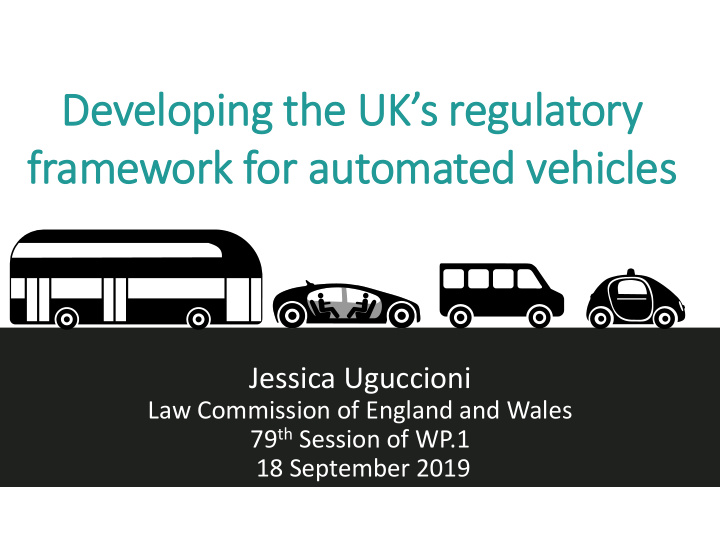



Developing the UK’s regulatory framework for automated vehicles Jessica Uguccioni Law Commission of England and Wales 79 th Session of WP.1 18 September 2019
The Law Commissions • Independent statutory bodies created in 1965 • Purpose: to keep the law up to date, simple, cost effective and fair
The Law Commissions’ three year project • Consultation Paper 1: safety and legal accountability (8 Nov 2018) • Consultation Paper 2: passenger services and public transport (Autumn 2019) • Consultation Paper 3: Bringing proposals together (2020) • Final report (2021)
Law Com Consultation Paper 1: : Safety and Legal Responsibility
Who responded?
Safety assurance scheme • Strong support for a national safety assurance scheme to complement international type approval • Prohibit unauthorised systems • Modifications and small series • Dutch ‘driving licence’ for self -driving cars • UK GOVERNMENT ACTION: CAV PASS announced 4/09/2019
Automated Driving System Entity • Role: submits ADS for authorisation and vouches for its safety • Presence in jurisdiction • Subject to range of regulatory sanctions • Most respondents (85%) agreed
Road incident investigation • General consensus that focus needs to shift from allocating blame to learning for the future • Need to review law on corporate offences where wrongs by developer result in death/serious injury • Short term: need to provide specialist help to police
Two development paths Path 1: Path 2: ▪ Consumer vehicles sold ▪ Sells a journey rather than across borders; a vehicle. ▪ Continue to have human in ▪ No driving seat the driving seat
Path 1: : User-In-Charge • Who: • Human in or line of sight of vehicle • Qualified and fit to drive • Role: • Non-dynamic control responsibilities, e.g. insurance, maintenance • Not responsible for dynamic control while ADS is engaged • Takes over from highly automated driving system
Path 1: : User-in in-charge • Key premise: if the User-In-Charge is not responsive the vehicle can come to a safe stop. • Most consultees (79%) agreed • 52% against secondary activities in conditional automation, SAE Level 3 • Remote operator ≠ user -in-charge
Upcoming Consultation Paper 2: : Automated Vehicles: Passenger Services & Public Transport KEY THEMES Focus on Path 2: passenger-only vehicles Aims of regulation Operator licensing: A single national system Private ownership Accessibility Local regulatory tools for controlling congestion and cruising Integration with public transport
Path th 2: passenger services
Highly Automated Road Passenger Services (H (HARPS) • A service which uses highly automated vehicles to supply journeys to passengers without a human driver or user-in-charge • For at least part of the journey, a HARPS would be able to travel empty or with only passengers on board. • Fleets providing mobility services
Operator as key concept for HARPS • Operating a fleet of vehicles vs developing ADS • Remote supervision • Responsible for maintenance, insurance, duties after an accident • Protocols for intervention in the event of ADS malfunction (e.g. removed a vehicle stopped in the middle of the road)
Legal responsibility for driving tasks Path 1: : Use ser-In In- Path 2: : HARPS fle fleet t Ch Charge vehic icle les vehic icle les Dyn ynamic ic ADSE ADSE Co Control Non- USER-IN-CHARGE HARPS OPERATOR Dyn ynamic ic Co Control
HARPS national operator licensing • We provisionally propose a new single national system to licence HARPS operators • New unified system not replicating distinctions between taxis, pre-booked only services and buses
Q&A automatedvehic icle les@la lawcommis issio ion.gov.uk
Recommend
More recommend